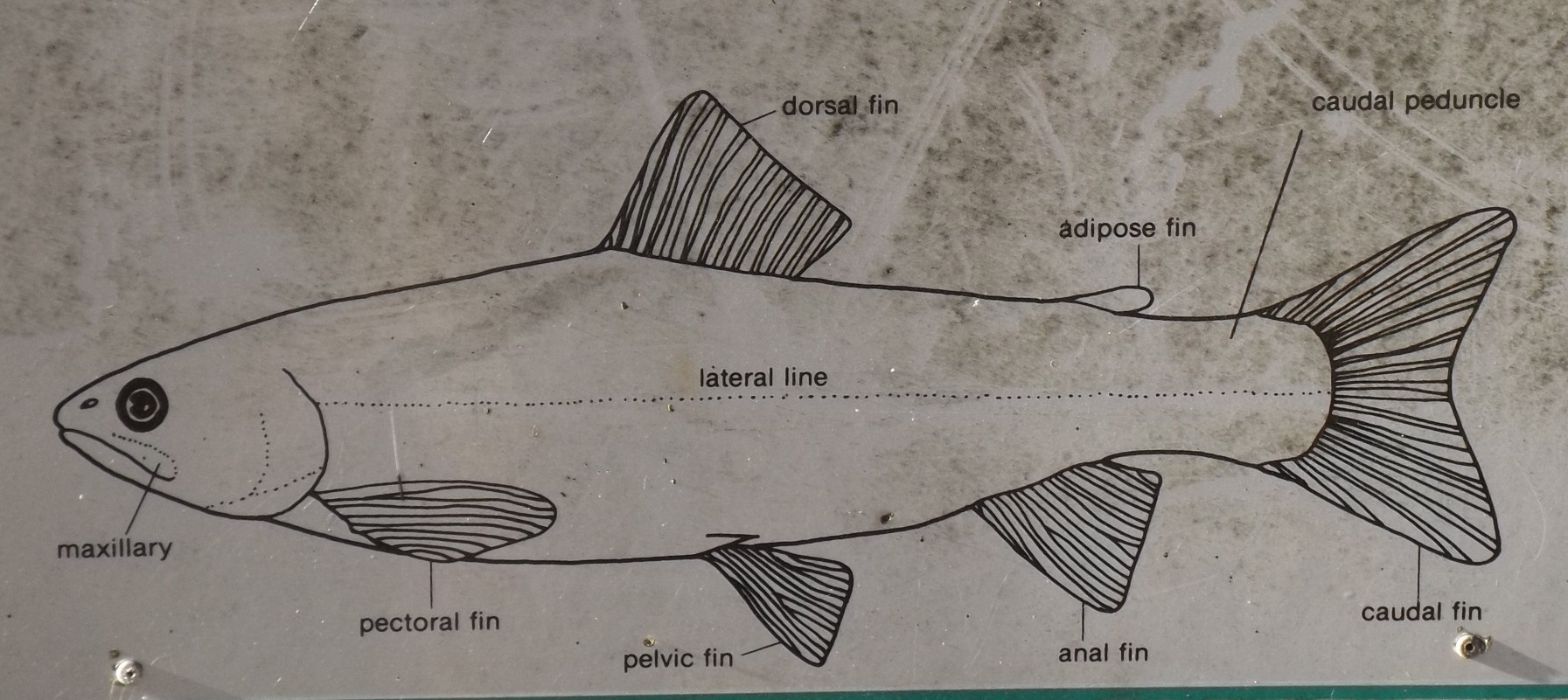This four-sided sign has lots of information, with one giving a bit of the history of the Rainbow Trout. It reads:
Rainbow Trout
"The first rainbow trout imported into New South Wales (and probably the first into Australia) arrived in 1894, coinciding with the establishment of ponds by the Commissioners below Prospect Reservoir. The Prospect site was the sole hatching centre until 1924, when a small hatchery was established on the Thredbo River on the old town of Jindabyne.
"The period 1926 to 1931 saw many hatcheries, both permanent and temporary, established using material and supervision, supplied by the Fisheries Department. Labour, caretakers' wages and some stock were provided by fishing organisations and individuals.
"The aim of the hatcheries was self-sufficiency, as up until that time large numbers of eggs were still being imported from New Zealand, Victoria and Tasmania. In fact the importation of trout ova continued until about 1955."
IDENTIFYING SPECIES
"Colour by itself is a poor way to identify species because of the large variation in colouration. The trout can control it's skin colour and pigmentation to some extent by signals from the eye to suit background shades. Thus, trout from shale bottomed, dark rivers are much darker than fish from deep holes or caves (the latter receive no light for the eye to perceive background shades). Diet also plays a role in trout colouration. Dark spots are lacking on brown trout in hatcheries where only liver and meat are fed. Eggs from these fish are also very pale yellow to white. Pink flesh in trout often indicates a crustacean diet (such as water-fleas and yabbies).
"To identify Rainbow trout you must look at the combination of a number of specific characteristics."
Rainbow Trout (Salmo gairderi)
* Maxillary long, usually passing eye. Tail and dorsal fin have regular and radiating rows of small black spots between fin rays.
* Colour very variable with habitat and size, spawning fish and river residents often darker than lake residents. Dorsal surface often blue-green. Sides silvery to grey with numerous small, dark spots and often with a pink-red band. Spots are not surrounded by haloes.
* Tail moderately forked, rather square in large individuals. Adipose fin has a black border.
* Young fish have 5 to 10 dark oval par marks along the sides (straddling the lateral line) and small dark spots above the lateral line. Adipose fin edged with black, few or no spots on tail.

Rainbow Trout cropped from the sign.
BIOLOGY
"Salmonids survive and grow only in cold, well oxygenated waters. In New South Wales, therefore they are restricted to the higher altitude area along the Great Dividing Range. Spawning (breeding) is further restricted to clear, shallow (30 cm is ideal) running water of sufficient velocity. Clean gravel is needed for the depositing of eggs. Rainbow trout have formed self-maintaining populations in various parts of the State, important areas being the New England Tablelands, the Central Western tablelands and the Southern Tablelands. As imports of brown trout into New Zealand originated from England, Germany and Italy, the stocks now present in Australia imported from New Zealand until 1955) are now also probably a mixture of all these fish once known as different varieties.
"Approximately 2 million trout are bred at the State's two hatcheries each year and released into public waters, largely into those where spawning is poor or non-existant. Spawning for the rainbow trout take place from mid-winter to spring."
TEMPERATURE
"The lower limit of trout survival is freezing point, although trout can survive in water under ice. Survival at the lower limit is, however, dependent on sufficient oxygen being available. Lower lethal temperatures are rarely encountered in New South Wales and of more importance are the upper critical temperatures that trout can tolerate. The ideal temperature range for trout survival and growth is 10° to 19°C and temperatures above 25°C can be lethal.
"Although trout are mostly restricted to high altitude areas, some good trout fishing can be found below large storage dams, which release the colder bottom water. Some trout farms are sited below such dams in areas where temperatures would otherwise be too high for trout culture.
"Water temperature can also be reduced by increased flow, increased depth and shade. Most lakes develop thermal stratification during the summer, with warmer water at the surface and colder water at the bottom, in between which is the zone of most rapid temperature change, known as the thermocline. During the summer trout avoid the hotter surface waters, particularly during the day, a fact fishermen use to advantage by using deep-diving lures or lead lines. In autumn the surface waters cool and become more dense, gradually sinking lower into the lake until their density and temperature match that of the bottom layer. At this stage the bottom waters rise and the lake water "turns over" circulating surface oxygen to the deeper zone and nutrients to the surface. Trout at this time are not restricted by warm surface waters and are more widely distributed in the water column."
Access: Park in the car park of Myra Vale Road, and then you will be able to see the multi-sided sign, on the other side of the fence around the Reservoir.
Visited: 0758, Sunday, 21 January, 2018